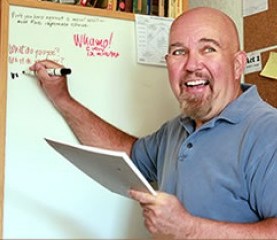The common wisdom is that screenwriters should take an acting class to understand what it’s like to be on the receiving end of a script. I suppose not doing so, would be like trying to design a boat without having ever taken one out on the water. OK, I’m getting on board.
The guide for me and the other students on this cruise is Caitlin Lopez, Associate Artistic Director for Ophelia’s Jump Productions.
June 7 – Walking Up and Down
We did a lot of walking around: Slow. Fast. Slow Motion. Powerful. The lesson was that posture and how an actor moves can tell you a lot about the character being portrayed.
I made a mental note to consider using words which suggest how a character is moving or standing. For instance, “Hands in pockets, Jeremy slouched toward the desk.”
We also learned what to call various positions on the stage. “Up Center” or “Down Right” and how where an actor entered the stage, influenced their perceived importance to the audience.
Interestingly, on stage, entering from the audience’s left, brings more attention than from the right, but in film, directors tend to pan from the right. As I watched films the next few days, I was much more aware of how my focus was being manipulated.
June 14 – Hitting on Bea Arthur
Today we got to see scripts and recipes — real recipes with ingredients and cooking instructions.
The recipes were part of an exercise named after Bea Arthur, who during her one-woman show on Broadway spent 20 minutes reading recipes. She did it with such emotion and expressiveness she would receive standing ovations.
Caitlin would give us a situation such as “Your fiancé just said ‘yes’ to your marriage proposal” or “You just stopped a robbery.” My classmates and I didn’t rise to Bea Arthur Level, but it was instructive to try to communicate with just delivery and emotion, but without relevant words.
The scripts took us to the other extreme. We paired off and had to come up with a way to give meaning to simple short scripts that had no stage direction or context.
Last, Caitlin directed us to choose a monologue to memorize and deliver. She had a big pile of books for us to select from. I suggested I could write my own. No go. “Performing someone else’s words,” Caitlin said, “is way different from performing something we’ve written ourselves.” Oh, yeah. That’s what I’m here to experience.
June 21 – Light Bulbs Start to Go On Above My Head
Three exercises tonight convinced me that this “take an acting class” project was paying off.
This one sounds silly. It was, but it was helpful. Caitlin sent us randomly walking around the room again, this time emulating some kind of animal. Then, she had us imagine that this animal was a character.
My first try, I was a roadrunner, which I morphed into a basketball draft pick who wanted to be the new LeBron. (Thank you, NBA Finals Game 7.)
Next, I was an elephant, who morphed into an old librarian. I thought about one of my ROTC buddies whom I admired for his athleticism and Special Forces ambitions, but who ended up majoring in Library Science.
Two characters for the price of none. (OK. For the price of walking around the room looking crazy.)
Next, we stood in a circle. One person made up a name, the next added an occupation, and the third added a belief. Student number four then had to create a mini-monologue for this person.
Takeaway: Make sure your actors have backstory to work with. It sparks their creativity.
The last exercise made me scribble down ideas in my notebook as students started to practice their monologues for the first time. The monologue will be our “final exam” on the last night of class.
As practice, discussion, and critique proceeded, I realized something about the four screenplays I have in various stages of completion. (They’re never really done, are they?) None of my protagonists had good monologues. Great monologues are what people remember.
I had fallen victim to the “make sure there’s lots of white space on the page” screenwriting rule. John, Eleanor, Martin, and Bonnie are about to get some epic speeches. I might write a couple for the bad guys, too.
To be continued…



1 comment for “Getting On Board with Acting – Part 1”